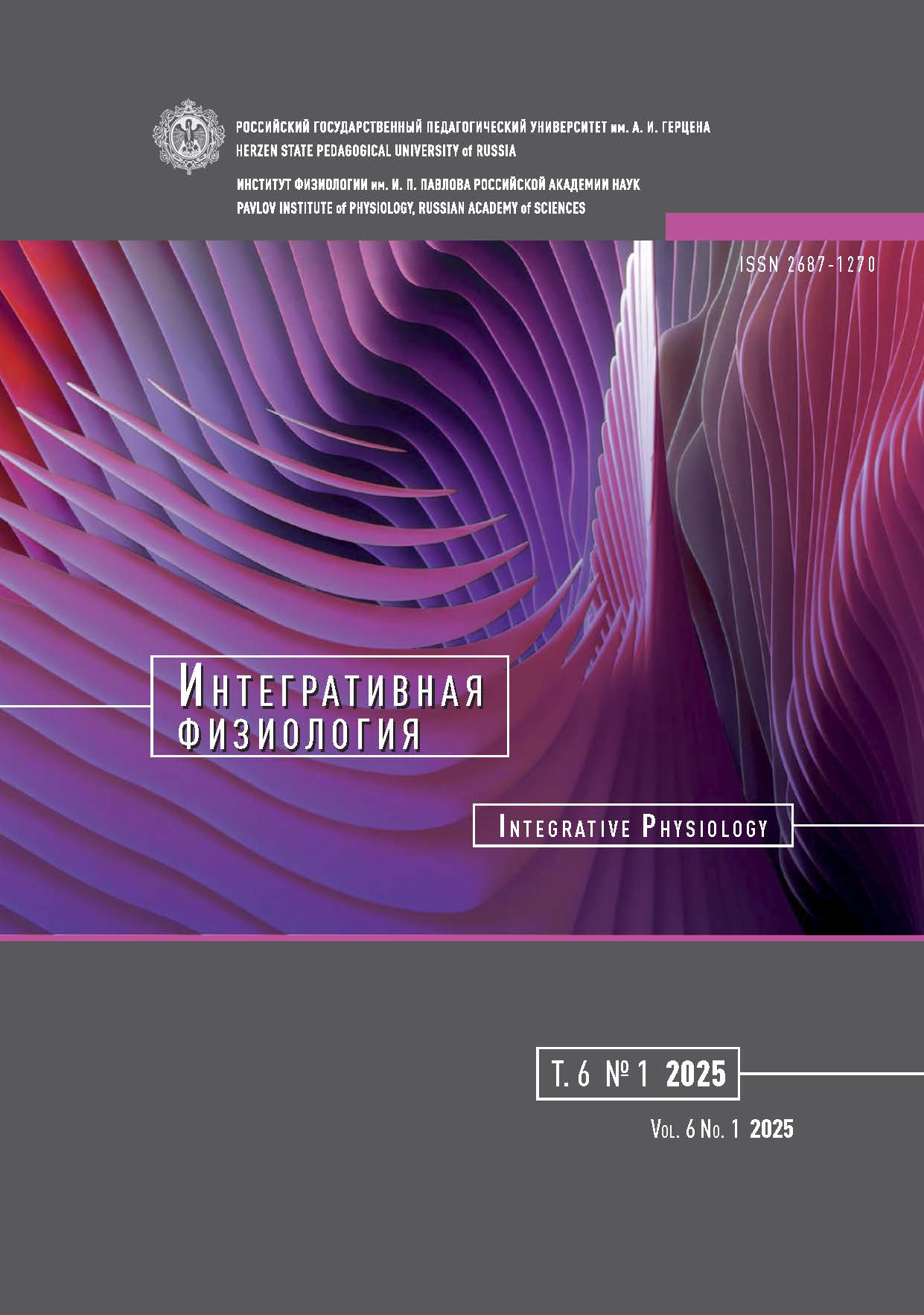Тест «лимита стабильности» вертикальной позы человека на стабилоплатформе
DOI:
https://doi.org/10.33910/2687-1270-2025-6-1-26-40Ключевые слова:
тест лимита стабильности, опорные реакции, стабилоплатформа, стабилограф, силовая платформа, вертикальная поза человекаАннотация
Исследование регуляции вертикальной позы человека имеет важное значение для научных исследований и клиники, особенно в контексте оценки баланса тела и риска падений. В последние десятилетия стабилоплатформы стали ключевым инструментом для объективизации в этой области. Однако их применение сопровождается рядом проблем, таких как отсутствие стандартизации приборов и методик, недостаточное метрологическое обеспечение и связанные с этим вопросы интерпретации результатов. Данный обзор подготовлен в стиле, близком к «integrative review», и направлен на поддержку методического обеспечения исследований постурального контроля, преодоление возможных искажений в этой области, призван способствовать повышению качества исследований. Фокус — на тест лимита стабильности (Limits of Stability Test), один из наиболее распространенных методов оценки границ управления равновесием при наклонах тела. Особое внимание уделено эволюции методик и технологий, а также современному состоянию вопроса. Несмотря на широкое использование стабилоплатформ, существует множество вариаций теста, что затрудняет сопоставление данных и разработку единых нормативов. Рассматриваются технические особенности оборудования, влияние локальных подходов производителей и проблемы воспроизводимости результатов. Обсуждаются альтернативные методы, такие как тест функционального дотягивания (Functional Reach Test), и их сравнение с тестом лимита стабильности. В заключение делается вывод о необходимости стандартизации методик и формирования надежной нормативной базы для объективной оценки регуляции вертикальной позы. Предлагается объединить усилия для преодоления локальных подходов и повышения качества исследований в областях, связанных с контролем позы и движений.
Библиографические ссылки
ЛИТЕРАТУРА
Анохин, П. К. (1968) Биология и нейрофизиология условного рефлекса. М.: Медицина, 547 с.
Бабанов, Н. Д., Каленова, А. А., Серченко, Я. А. и др. (2019) Стандартизация, взаимозаменяемость и анализ предложений стабилоплатформ в России. Проблемы стандартизации в здравоохранении, № 9-10, с. 10–17. https://doi.org/10.26347/1607-2502201909-10010-017
Гроховский, С. С., Кубряк, О. В. (2018) Метод интегральной оценки эффективности регуляции позы человека. Медицинская техника, № 2 (308), с. 49–52.
Гурфинкель, В. С., Коц, Я. М., Шик, М. Л. (1965) Регуляция позы человека. М.: Наука, 256 с.
Кожина, Г. В., Левик, Ю. С., Попов, А. К., Сметанин, Б. Н. (2017) Влияние пассивного тактильного контакта руки на поддержание вертикальной позы человека. Физиология человека, т. 43, № 4, с. 70–77. https://doi.org/10.7868/S0131164617030092
Крикленко, Е. А., Кубряк, О. В. (2018) Анализ научной области на примере исследования российских патентов. Мониторинг общественного мнения: Экономические и социальные перемены, № 4 (146), с. 229–249. https://doi.org/10.14515/monitoring.2018.4.12
Кубряк, О. В. (2020) Как техника предшествует науке (на примере силовых платформ). Гуманитарный вестник, № 2 (82), с. 1–13. https://doi.org/10.18698/2306-8477-2020-2-656
Кубряк, О. В., Багдасарьян, Н. Г., Глазачев, О. С. и др. (2018) Инструменты исследователя и врача: границы достижимых результатов и влияние на выводы исследований. По материалам круглого стола на XIV Вейновских чтениях, 10 февраля 2018 года. К 120-летию П. К. Анохина. Мониторинг общественного мнения: Экономические и социальные перемены, № 6 (148), с. 386–406. https://doi.org/10.14515/monitoring.2018.6.18
Кубряк, О. В., Ковальчук, С. В. (2024) Искусственный сенсорный компонент в системе человек — машина с комбинированной обратной связью. Проблемы управления, № 6, с. 27–37.
Кубряк, О. В., Кривошей, И. В. (2016) Анализ научной области на примере обзора диссертационных работ. Мониторинг общественного мнения: Экономические и социальные перемены, № 6 (136), с. 52–68. https://doi.org/10.14515/monitoring.2016.6.04
Кубряк, О. В., Мезенчук, А. И., Пак, С. А. (2023) Применение стабилоплатформ и корпус экспертов в российских диссертациях за 2016–2022 годы. Физиотерапия, бальнеология и реабилитация, т. 22, № 2, с. 105–114. https://doi.org/10.17816/430299
Левик, Ю. С. (2020) Исследования в космосе и новые концепции в физиологии движений. Авиакосмическая и экологическая медицина, т. 54, № 6, с. 80–91. https://doi.org/10.21687/0233-528X-2020-54-6-80-91
Магнус, Р. (1962) Установка тела: экспериментально-физиологические исследования отдельных определяющих установку тела рефлексов, их взаимных влияний и их расстройств. М.; Л.: Академия наук СССР, 624 с.
Akbaş, E., İnanır, M. (2025) Evaluation of balance in children with hemophilia and the effect of balance on quality of life. Gait & Posture, vol. 117, pp. 332–336. https://doi.org/10.1016/j.gaitpost.2025.01.015
Alahmari, K. A., Reddy, R. S. (2024) Biomechanical analysis of limits of stability using computerized posturography: Correlations with functional mobility in elderly individuals with hip osteoarthritis — a cross-sectional study. Frontiers in Bioengineering and Biotechnology, vol. 12, article 1440393. https://doi.org/10.3389/fbioe.2024.1440393
Alshehri, S. H. S., Reddy, R. S., ALMohiza, M. A. et al. (2025) Influence of cervical muscle strength and pain severity on functional balance and limits of stability in elderly individuals with chronic nonspecific neck pain: A cross-sectional study. BMC Geriatrics, vol. 25, no. 1, article 18. https://doi.org/10.1186/s12877-024-05670-2
Barra-López, M. E. (2024) The standard posture is a myth: A scoping review. Journal of Rehabilitation Medicine, vol. 56, article jrm41899. https://doi.org/10.2340/jrm.v56.41899
Braune, W., Fischer, O. (1985) On the centre of gravity of the human body (as related to the equipment of the German infantry soldier). Berlin; Heidelberg: Springer Publ., 96 p. https://doi.org/10.1007/978-3-642-69611-4
Chen, B., Liu, P., Xiao, F. et al. (2021) Review of the upright balance assessment based on the force plate. International Journal of Environmental Research and Public Health, vol. 18, no. 5, article 2696. https://doi.org/10.3390/ijerph18052696
Clark, S., Rose, D. J., Fujimoto, K. (1997) Generalizability of the limits of stability test in the evaluation of dynamic balance among older adults. Archives of Physical Medicine and Rehabilitation, vol. 78, no. 10, pp. 1078–1084. https://doi.org/10.1016/s0003-9993(97)90131-3
Cohen, J. W., Vieira, T. M., Ivanova, T. D., Garland, S. J. (2023) Regional recruitment and differential behavior of motor units during postural control in older adults. Journal of Neurophysiology, vol. 130, no. 5, pp. 1321–1333. https://doi.org/10.1152/jn.00068.2023
Cohen, J. W., Vieira, T. M., Ivanova, T. D. et al. (2021) Maintenance of standing posture during multi-directional leaning demands the recruitment of task-specific motor units in the ankle plantarflexors. Experimental Brain Research, vol. 239, no. 8, pp. 2569–2581. https://doi.org/10.1007/s00221-021-06154-0
Collins, H. (2010) Tacit and explicit knowledge. Chicago: University of Chicago Press, 200 p. https://doi.org/10.7208/chicago/9780226113821.001.0001
De Souza, M. T., da Silva, M. D., de Carvalho, R. (2010) Integrative review: What is it? How to do it? Einstein (São Paulo), vol. 8, no. 1, pp. 102–106. https://doi.org/10.1590/s1679-45082010rw1134
Duarte, M., Watanabe, R. N. (2023) Postural control in humans: Theories, modeling, and quantification. In: C. B. Lombello, P. A. da Ana (eds.). Current trends in biomedical engineering. Cham: Springer Publ., pp. 17–34. https://doi.org/10.1007/978-3-031-38743-2_2
Duncan, P. W., Weiner, D. K., Chandler, J., Studenski, S. (1990) Functional reach: A new clinical measure of balance. Journal of Gerontology, vol. 45, no. 6, pp. M192–M197. https://doi.org/10.1093/geronj/45.6.m192
Francisco, L., Duarte, J., Godinho, A. N. et al. (2024) Sensor-based systems for the measurement of Functional Reach Test results: A systematic review. PeerJ Computer Science, vol. 10, no. 1, article e1823. https://doi. org/10.7717/peerj-cs.1823
Glave, A. P., Didier, J. J., Weatherwax, J. et al. (2016) Testing postural stability: Are the Star Excursion Balance Test and Biodex Balance System Limits of Stability Tests consistent? Gait & Posture, vol. 43, pp. 225–227. https://doi.org/10.1016/j.gaitpost.2015.09.028
Goar, M. H., Barnett-Cowan, M., Horslen, B. C. (2025) Light touch alters vestibular-evoked balance responses: Insights into dynamics of sensorimotor reweighting. Journal of Neurophysiology, vol. 133, no. 1, pp. 142–161. https://doi.org/10.1152/jn.00166.2024
Hamman, R. G., Mekjavic, I., Mallinson, A. I., Longridge, N. S. (1992) Training effects during repeated therapy sessions of balance training using visual feedback. Archives of Physical Medicine and Rehabilitation, vol. 73, no. 8, pp. 738–744. https://pubmed.ncbi.nlm.nih.gov/1642525
Haworth, J., Goble, D., Pile, M., Kendall, B. (2020) BTrackS limits of stability test is a reliable assessment of volitional dynamic postural control. Gait & Posture, vol. 80, pp. 298–301. https://doi.org/10.1016/j.gaitpost.2020.06.024
Horak, F. B., Wrisley, D. M., Frank, J. (2009) The Balance Evaluation Systems Test (BESTest) to differentiate balance deficits. Physical Therapy, vol. 89, no. 5, pp. 484–498. https://doi.org/10.2522/ptj.20080071
Hou, W., Wu, F., Wang, Y. et al. (2024) Predicting slight freezing of gait in Parkinson’s disease with anticipatory postural adjustments and limits of stability. Parkinsonism & Related Disorders, vol. 123, article 106949. https://doi.org/10.1016/j.parkreldis.2024.106949
Ivanenko, Y., Gurfinkel, V. S. (2018) Human postural control. Frontiers in Neuroscience, vol. 12, article 171. https://doi.org/10.3389/fnins.2018.00171
Karanfil, E., Salci, Y., Fil Balkan, A. et al. (2024) The acute effect of cervical mobilization on balance in patients with multiple sclerosis: A single-blind, randomized, controlled trial. Neurological Research, vol. 46, no. 1, pp. 65–71. https://doi.org/10.1080/01616412.2023.2257455
Kattilakoski, O., Kauranen, N., Leppänen, M. et al. (2023) Intrarater reliability and analysis of learning effects in the Y Balance Test. Methods and Protocols, vol. 6, no. 2, article 41. https://doi.org/10.3390/mps6020041
Kim, S.-M., Qu, F., Lam, W.-K. (2021) Analogy and explicit motor learning in dynamic balance: Posturography and performance analyses. European Journal of Sport Science, vol. 21, no. 8, pp. 1129–1139. https://doi.org/10.1080/17461391.2020.1827046
Lektip, C., Rungruangbaiyok, C., Nawarat, J. et al. (2024) The relationship between components of postural control and locomotive syndrome in older adults. International Journal of Environmental Research and Public Health, vol. 21, no. 10, article 1349. https://doi.org/10.3390/ijerph21101349
Lininger, M. R., Leahy, T. E., Haug, E. C., Bowman, T. G. (2018) Test-retest reliability of the limits of stability test performed by young adults using Neurocom® Vsr Sport. International Journal of Sports Physical Therapy, vol. 13, no. 5, pp. 800–807. https://pubmed.ncbi.nlm.nih.gov/30276012
Miner, D. G., Harper, B. A., Glass, S. M. (2020) Validity of postural sway assessment on the Biodex BioSway™ compared with the NeuroCom Smart Equitest. Journal of Sport Rehabilitation, vol. 30, no. 3, pp. 516–520. https://doi.org/10.1123/jsr.2020-0227
Moriyama, Y., Yamada, T., Shimamura, R. et al. (2022) Movement patterns of the functional reach test do not reflect physical function in healthy young and older participants. PLoS One, vol. 17, no. 3, article e0266195. https://doi.org/10.1371/journal.pone.0266195
Nashner, L. M. (1971) A model describing vestibular detection of body sway motion. Acta Oto-Laryngologica, vol. 72, no. 1-6, pp. 429–436. https://doi.org/10.3109/00016487109122504
Nashner, L. M. (1972) Vestibular postural control model. Kybernetik, vol. 10, no. 2, pp. 106–110. https://doi.org/10.1007/BF00292236
Nashner, L. M., Cordo, P. J. (1981) Relation of automatic postural responses and reaction-time voluntary movements of human leg muscles. Experimental Brain Research, vol. 43, no. 3-4, pp. 395–405. https://doi.org/10.1007/BF00238382
Natus Medical Incorporated to acquire NeuroCom International for $18M. (2008) BioSpace. [Online]. Available at: https://www.biospace.com/natus-medical-incorporated-to-acquire-neurocom-international-for-18m (accessed 10.02.2025).
Nolff, M. R., Kapur, S., Kendall, B. J. et al. (2024) An initial set of reference values for the Balance Tracking System (BTrackS) Limits of Stability protocol. Gait & Posture, vol. 107, pp. 67–71. https://doi.org/10.1016/j.gaitpost.2023.09.008
Onuma, R., Hoshi, F., Tozawa, R. et al. (2023) Reliability and validity of quantitative evaluation of anticipatory postural adjustments using smartphones. Journal of Physical Therapy Science, vol. 35, no. 7, pp. 553–558. https://doi.org/10.1589/jpts.35.553
Peterka, R. J., Loughlin, P. J. (2004) Dynamic regulation of sensorimotor integration in human postural control. Journal of Neurophysiology, vol. 91, no. 1, pp. 410–423. https://doi.org/10.1152/jn.00516.2003
Pickerill, M. L., Harter, R. A. (2011) Validity and reliability of limits-of-stability testing: A comparison of 2 postural stability evaluation devices. Journal of Athletic Training, vol. 46, no. 6, pp. 600–606. https://doi.org/10.4085/1062-6050-46.6.600
Piolanti, N., Polloni, S., Bonicoli, E. et al. (2018) Giovanni Alfonso Borelli: The precursor of medial pivot concept in knee biomechanics. Joints, vol. 6, no. 3, pp. 167–172. https://doi.org/10.1055/s-0038-1675164
Pope, M. H. (2005) Giovanni Alfonso Borelli — the father of biomechanics. Spine, vol. 30, no. 20, pp. 2350–2355. https://doi.org/10.1097/01.brs.0000182314.49515.d8
Reddy, R. S., Alkhamis, B. A., Kirmani, J. A. et al. (2023) Age-related decline in cervical proprioception and its correlation with functional mobility and limits of stability assessed using computerized posturography: A cross-sectional study comparing older (65+ years) and younger adults. Healthcare, vol. 11, no. 13, article 1924. https://doi.org/10.3390/healthcare11131924
Schieppati, M., Hugon, M., Grasso, M. et al. (1994) The limits of equilibrium in young and elderly normal subjects and in parkinsonians. Electroencephalography and Clinical Neurophysiology/Evoked Potentials Section, vol. 93, no. 4, pp. 286–298. https://doi.org/10.1016/0168-5597(94)90031-0
Shumway-Cook, A., Woollacott, M. H., Rachwani, J., Santamaria, V. (2023) Motor control: Translating research into clinical practice. 6th ed. Philadelphia: Lippincott Williams & Wilkins Publ., 736 p.
Song, M., Elson, J., Bastola, D. (2025) Digital Age transformation in patient-physician communication: 25-year narrative review (1999–2023). Journal of Medical Internet Research, vol. 27, article e60512. https://doi.org/10.2196/60512
Summers, S. J., Antcliff, S., Waddington, G., Wallwork, S. (2022) Reliability and learning effects of repeated exposure to the Bertec Balance Advantage sensory organisation test in healthy individuals. Gait & Posture, vol. 93, pp. 205–211. https://doi.org/10.1016/j.gaitpost.2022.02.004
Tandon, A., Cobb, B., Centra, J. et al. (2024) Human factors, human-centered design, and usability of sensor-based digital health technologies: Scoping review. Journal of Medical Internet Research, vol. 26, article e57628. https://doi.org/10.2196/57628
Terekhov, Y. (1976) Stabilometry as a diagnostic tool in clinical medicine. Canadian Medical Association Journal, vol. 115, no. 7, pp. 631–633. https://pubmed.ncbi.nlm.nih.gov/974950
Thomsen, M. H., Støttrup, N., Larsen, F. G. et al. (2017) Four-way-leaning test shows larger limits of stability than a circular-leaning test. Gait & Posture, vol. 51, pp. 10–13. https://doi.org/10.1016/j.gaitpost.2016.09.018
Tomita, H., Kuno, S., Kawaguchi, D., Nojima, O. (2021) Limits of stability and functional base of support while standing in community-dwelling older adults. Journal of Motor Behavior, vol. 53, no. 1, pp. 83–91. https://doi.org/10.1080/00222895.2020.1723484
Uchida, H., Miki, A., Ida, A. et al. (2024) Effects of structured positive feedback intervention on standing reach ability among older adults admitted to a convalescent rehabilitation ward: A small-sample pilot randomized controlled trial. European Geriatric Medicine, vol. 16, no. 1, pp. 325–336. https://doi.org/10.1007/s41999-024- 01094-8
Wernick-Robinson, M., Krebs, D. E., Giorgetti, M. M. (1999) Functional reach: Does it really measure dynamic balance? Archives of Physical Medicine and Rehabilitation, vol. 80, no. 3, pp. 262–269. https://doi.org/10.1016/s0003-9993(99)90136-3
REFERENCES
Akbaş, E., İnanır, M. (2025) Evaluation of balance in children with hemophilia and the effect of balance on quality of life. Gait & Posture, vol. 117, pp. 332–336. https://doi.org/10.1016/j.gaitpost.2025.01.015 (In English)
Alahmari, K. A., Reddy, R. S. (2024) Biomechanical analysis of limits of stability using computerized posturography: Correlations with functional mobility in elderly individuals with hip osteoarthritis — a cross-sectional study. Frontiers in Bioengineering and Biotechnology, vol. 12, article 1440393. https://doi.org/10.3389/fbioe.2024.1440393 (In English)
Alshehri, S. H. S., Reddy, R. S., ALMohiza, M. A. et al. (2025) Influence of cervical muscle strength and pain severity on functional balance and limits of stability in elderly individuals with chronic nonspecific neck pain: A cross-sectional study. BMC Geriatrics, vol. 25, no. 1, article 18. https://doi.org/10.1186/s12877-024-05670-2 (In English)
Anokhin, P. K. (1968) Biologiya i nejrofiziologiya uslovnogo refleksa [Biology and neurophysiology of the conditioned reflex]. Moscow: Meditsina Publ., 547 p. (In Russian)
Babanov, N. D., Kalenova, A. A., Serchenko, Ya. A. et al. (2019) Standartizatsiya, vzaimozamenyaemost’ i analiz predlozhenij stabiloplatform v Rossii [Standardization, interoperability and market of force platforms in Russia]. Problemy standartizatsii v zdravookhranenii — Health Care Standardization Problems, no. 9–10, pp. 10–17. https://doi.org/10.26347/1607-2502201909-10010-017 (In Russian)
Barra-López, M. E. (2024) The standard posture is a myth: A scoping review. Journal of Rehabilitation Medicine, vol. 56, article jrm41899. https://doi.org/10.2340/jrm.v56.41899 (In English)
Braune, W., Fischer, O. (1985) On the centre of gravity of the human body (as related to the equipment of the German infantry soldier). Berlin; Heidelberg: Springer Publ., 96 p. https://doi.org/10.1007/978-3-642-69611-4 (In English)
Chen, B., Liu, P., Xiao, F. et al. (2021) Review of the upright balance assessment based on the force plate. International Journal of Environmental Research and Public Health, vol. 18, no. 5, article 2696. https://doi.org/10.3390/ijerph18052696 (In English)
Clark, S., Rose, D. J., Fujimoto, K. (1997) Generalizability of the limits of stability test in the evaluation of dynamic balance among older adults. Archives of Physical Medicine and Rehabilitation, vol. 78, no. 10, pp. 1078–1084. https://doi.org/10.1016/s0003-9993(97)90131-3 (In English)
Cohen, J. W., Vieira, T. M., Ivanova, T. D., Garland, S. J. (2023) Regional recruitment and differential behavior of motor units during postural control in older adults. Journal of Neurophysiology, vol. 130, no. 5, pp. 1321–1333. https://doi.org/10.1152/jn.00068.2023 (In English)
Cohen, J. W., Vieira, T. M., Ivanova, T. D. et al. (2021) Maintenance of standing posture during multi-directional leaning demands the recruitment of task-specific motor units in the ankle plantarflexors. Experimental Brain Research, vol. 239, no. 8, pp. 2569–2581. https://doi.org/10.1007/s00221-021-06154-0 (In English)
Collins, H. (2010) Tacit and explicit knowledge. Chicago: University of Chicago Press, 200 p. https://doi.org/10.7208/chicago/9780226113821.001.0001 (In English)
De Souza, M. T., da Silva, M. D., de Carvalho, R. (2010) Integrative review: What is it? How to do it? Einstein (São Paulo), vol. 8, no. 1, pp. 102–106. https://doi.org/10.1590/s1679-45082010rw1134 (In English)
Duarte, M., Watanabe, R. N. (2023) Postural control in humans: Theories, modeling, and quantification. In: C. B. Lombello, P. A. da Ana (eds.). Current trends in biomedical engineering. Cham: Springer Publ., pp. 17–34. https://doi.org/10.1007/978-3-031-38743-2_2 (In English)
Duncan, P. W., Weiner, D. K., Chandler, J., Studenski, S. (1990) Functional reach: A new clinical measure of balance. Journal of Gerontology, vol. 45, no. 6, pp. M192–M197. https://doi.org/10.1093/geronj/45.6.m192 (In English)
Francisco, L., Duarte, J., Godinho, A. N. et al. (2024) Sensor-based systems for the measurement of Functional Reach Test results: A systematic review. PeerJ Computer Science, vol. 10, no. 1, article e1823. https://doi.org/10.7717/peerj-cs.1823 (In English)
Glave, A. P., Didier, J. J., Weatherwax, J. et al. (2016) Testing postural stability: Are the Star Excursion Balance Test and Biodex Balance System Limits of Stability Tests consistent? Gait & Posture, vol. 43, pp. 225–227. https://doi.org/10.1016/j.gaitpost.2015.09.028 (In English)
Goar, M. H., Barnett-Cowan, M., Horslen, B. C. (2025) Light touch alters vestibular-evoked balance responses: Insights into dynamics of sensorimotor reweighting. Journal of Neurophysiology, vol. 133, no. 1, pp. 142–161. https://doi.org/10.1152/jn.00166.2024 (In English)
Grokhovskii, S. S., Kubryak, O. V. (2018) Metod integral’noj otsenki effektivnosti regulyatsii pozy cheloveka [A method for integral assessment of the effectiveness of posture regulation in humans]. Meditsinskaya tekhnika — Biomedical Engineering, vol. 52, no. 2, pp. 138–141. https://doi.org/10.1007/s10527-018-9799-7 (In Russian)
Gurfinkel’, V. S., Kocz, Ya. M., Shik, M. L. (1965) Regulyatsiya pozy cheloveka [Regulation of human posture]. Moscow: Nauka Publ., 256 p. (In Russian)
Hamman, R. G., Mekjavic, I., Mallinson, A. I., Longridge, N. S. (1992) Training effects during repeated therapy sessions of balance training using visual feedback. Archives of Physical Medicine and Rehabilitation, vol. 73, no. 8, pp. 738–744. https://pubmed.ncbi.nlm.nih.gov/1642525 (In English)
Haworth, J., Goble, D., Pile, M., Kendall, B. (2020) BTrackS limits of stability test is a reliable assessment of volitional dynamic postural control. Gait & Posture, vol. 80, pp. 298–301. https://doi.org/10.1016/j.gaitpost.2020.06.024 (In English)
Horak, F. B., Wrisley, D. M., Frank, J. (2009) The Balance Evaluation Systems Test (BESTest) to differentiate balance deficits. Physical Therapy, vol. 89, no. 5, pp. 484–498. https://doi.org/10.2522/ptj.20080071 (In English)
Hou, W., Wu, F., Wang, Y. et al. (2024) Predicting slight freezing of gait in Parkinson’s disease with anticipatory postural adjustments and limits of stability. Parkinsonism & Related Disorders, vol. 123, article 106949. https://doi.org/10.1016/j.parkreldis.2024.106949 (In English)
Ivanenko, Y., Gurfinkel, V. S. (2018) Human postural control. Frontiers in Neuroscience, vol. 12, article 171. https://doi.org/10.3389/fnins.2018.00171 (In English)
Karanfil, E., Salci, Y., Fil Balkan, A. et al. (2024) The acute effect of cervical mobilization on balance in patients with multiple sclerosis: A single-blind, randomized, controlled trial. Neurological Research, vol. 46, no. 1, pp. 65–71. https://doi.org/10.1080/01616412.2023.2257455 (In English)
Kattilakoski, O., Kauranen, N., Leppänen, M. et al. (2023) Intrarater reliability and analysis of learning effects in the Y Balance Test. Methods and Protocols, vol. 6, no. 2, article 41. https://doi.org/10.3390/mps6020041 (In English)
Kim, S.-M., Qu, F., Lam, W.-K. (2021) Analogy and explicit motor learning in dynamic balance: Posturography and performance analyses. European Journal of Sport Science, vol. 21, no. 8, pp. 1129–1139. https://doi.org/10.1080/17461391.2020.1827046 (In English)
Kozhina, G. V., Levik, Y. S., Popov, A. K., Smetanin, B. N. (2017) Vliyanie passivnogo taktil’nogo kontakta ruki na podderzhanie vertikal’noj pozy cheloveka [Influence of passive tactile contact of arms on the maintenance of upright posture in humans]. Fiziologiya cheloveka — Human Physiology, vol. 43, no. 4, pp. 416–422. https://doi.org/10.1134/S0362119717030094 (In Russian)
Kriklenko, E. A., Kubryak, O. V. (2018) Analiz nauchnoj oblasti na primere issledovaniya rossijskikh patentov [Analyzing an academic field: The case of Russian patents]. Monitoring obshchestvennogo mneniya: Ekonomicheskie i sotsial’nye peremeny — Monitoring of Public Opinion: Economic and Social Changes, no. 4 (146), pp. 229–249. https://doi.org/10.14515/monitoring.2018.4.12 (In Russian)
Kubryak, O. V. (2020) Kak tekhnika predshеstvuet nauke (na primere silovykh platform) [How technology precedes science (through the example of force plates)]. Gumanitarnyj vestnik — Humanities Bulletin of BMSTU, no. 2 (82), pp. 1–13. https://doi.org/10.18698/2306-8477-2020-2-656 (In Russian)
Kubryak, O. V., Bagdasaryan, N. G., Glazachev, O. S. et al. (2018) Instrumenty issledovatelya i vracha: granitsy dostizhimykh rezul’tatov i vliyanie na vyvody issledovanij. Po materialam kruglogo stola na XIV Vejnovskikh chteniyakh, 10 fevralya 2018 goda. K 120-letiyu P. K. Anokhina [Researcher’s and doctor’s tools: The boundaries of achievable results and the impact on the study findings. Proceedings of the XIV Vein Conference round table held on February 10th, 2018 (to the 120th anniversary of P. K. Anokhin)]. Monitoring obshchestvennogo mneniya: Ekonomicheskie i sotsial’nye peremeny — Monitoring of Public Opinion: Economic and Social Changes, no. 6 (148), pp. 386–406. https://doi.org/10.14515/monitoring.2018.6.18 (In Russian)
Kubryak, O. V., Kovalchuk, S. V. (2024) Iskusstvennyj sensornyj komponent v sisteme chelovek — mashina s kombinirovannoj obratnoj svyaz’yu [An artificial sensory component in a man — machine system with combined feedback]. Problemy upravleniya — Control Sciences, no. 6, pp. 27–37. (In Russian)
Kubryak, O. V., Krivoshey, I. V. (2016) Analiz nauchnoj oblasti na primere obzora dissertatsionnykh rabot [Scientific field analysis based on the review of dissertation works]. Monitoring obshchestvennogo mneniya: Ekonomicheskie i sotsial’nye peremeny — Monitoring of Public Opinion: Economic and Social Changes, no. 6 (136), pp. 52–68. https://doi.org/10.14515/monitoring.2016.6.04 (In Russian)
Kubryak, O. V., Mezenchuk, A. I., Pak, S. A. (2023) Primenenie stabiloplatform i korpus ekspertov v rossijskikh dissertatsiyakh za 2016–2022 gody [The application of force plates and the community of experts in Russian dissertations for 2016–2022]. Fizioterapiya, bal’neologiya i reabilitatsiya — Russian Journal of Physiotherapy, Balneology and Rehabilitation, vol. 22, no. 2, pp. 105–114. https://doi.org/10.17816/430299 (In Russian)
Lektip, C., Rungruangbaiyok, C., Nawarat, J. et al. (2024) The relationship between components of postural control and locomotive syndrome in older adults. International Journal of Environmental Research and Public Health, vol. 21, no. 10, article 1349. https://doi.org/10.3390/ijerph21101349 (In English)
Levik, Yu. S. (2020) Issledovaniya v kosmose i novye kontseptsii v fiziologii dvizhenij [Space researches and new concepts in the physiology of movements]. Aviakosmicheskaya i ekologicheskaya meditsina — Aerospace and Environmental Medicine, vol. 54, no. 6, pp. 80–91. https://doi.org/10.21687/0233-528X-2020-54-6-80-91 (In Russian)
Lininger, M. R., Leahy, T. E., Haug, E. C., Bowman, T. G. (2018) Test-retest reliability of the limits of stability test performed by young adults using Neurocom® Vsr Sport. International Journal of Sports Physical Therapy, vol. 13, no. 5, pp. 800–807. https://pubmed.ncbi.nlm.nih.gov/30276012 (In English)
Magnus, R. (1962) Ustanovka tela: eksperimental’no-fiziologicheskie issledovaniya otdel’nykh opredelyayushchikh ustanovku tela refleksov, ikh vzaimnykh vliyanij i ikh rasstrojstv [Body posture: Experimental-physiological investigations of the reflexes involved in body posture, their cooperation and disturbances]. Moscow; Leningrad: Academy of Sciences of the USSR Publ., 624 p. (In Russian)
Miner, D. G., Harper, B. A., Glass, S. M. (2020) Validity of postural sway assessment on the Biodex BioSway™ compared with the NeuroCom Smart Equitest. Journal of Sport Rehabilitation, vol. 30, no. 3, pp. 516–520. https://doi.org/10.1123/jsr.2020-0227 (In English)
Moriyama, Y., Yamada, T., Shimamura, R. et al. (2022) Movement patterns of the functional reach test do not reflect physical function in healthy young and older participants. PLoS One, vol. 17, no. 3, article e0266195. https://doi.org/10.1371/journal.pone.0266195 (In English)
Nashner, L. M. (1971) A model describing vestibular detection of body sway motion. Acta Oto-Laryngologica, vol. 72, no. 1-6, pp. 429–436. https://doi.org/10.3109/00016487109122504 (In English)
Nashner, L. M. (1972) Vestibular postural control model. Kybernetik, vol. 10, no. 2, pp. 106–110. https://doi.org/10.1007/BF00292236 (In English)
Nashner, L. M., Cordo, P. J. (1981) Relation of automatic postural responses and reaction-time voluntary movements of human leg muscles. Experimental Brain Research, vol. 43, no. 3-4, pp. 395–405. https://doi.org/10.1007/BF00238382 (In English)
Natus Medical Incorporated to acquire NeuroCom International for $18M. (2008) BioSpace. [Online]. Available at: https://www.biospace.com/natus-medical-incorporated-to-acquire-neurocom-international-for-18m (accessed 10.02.2025). (In English)
Nolff, M. R., Kapur, S., Kendall, B. J. et al. (2024) An initial set of reference values for the Balance Tracking System (BTrackS) Limits of Stability protocol. Gait & Posture, vol. 107, pp. 67–71. https://doi.org/10.1016/j.gaitpost.2023.09.008 (In English)
Onuma, R., Hoshi, F., Tozawa, R. et al. (2023) Reliability and validity of quantitative evaluation of anticipatory postural adjustments using smartphones. Journal of Physical Therapy Science, vol. 35, no. 7, pp. 553–558. https://doi.org/10.1589/jpts.35.553 (In English)
Peterka, R. J., Loughlin, P. J. (2004) Dynamic regulation of sensorimotor integration in human postural control. Journal of Neurophysiology, vol. 91, no. 1, pp. 410–423. https://doi.org/10.1152/jn.00516.2003 (In English)
Pickerill, M. L., Harter, R. A. (2011) Validity and reliability of limits-of-stability testing: A comparison of 2 postural stability evaluation devices. Journal of Athletic Training, vol. 46, no. 6, pp. 600–606. https://doi.org/10.4085/1062-6050-46.6.600 (In English)
Piolanti, N., Polloni, S., Bonicoli, E. et al. (2018) Giovanni Alfonso Borelli: The precursor of medial pivot concept in knee biomechanics. Joints, vol. 6, no. 3, pp. 167–172. https://doi.org/10.1055/s-0038-1675164 (In English)
Pope, M. H. (2005) Giovanni Alfonso Borelli — the father of biomechanics. Spine, vol. 30, no. 20, pp. 2350–2355. https://doi.org/10.1097/01.brs.0000182314.49515.d8 — (In English)
Reddy, R. S., Alkhamis, B. A., Kirmani, J. A. et al. (2023) Age-related decline in cervical proprioception and its correlation with functional mobility and limits of stability assessed using computerized posturography: A cross-sectional study comparing older (65+ years) and younger adults. Healthcare, vol. 11, no. 13, article 1924. https://doi.org/10.3390/healthcare11131924 (In English)
Schieppati, M., Hugon, M., Grasso, M. et al. (1994) The limits of equilibrium in young and elderly normal subjects and in parkinsonians. Electroencephalography and Clinical Neurophysiology/Evoked Potentials Section, vol. 93, no. 4, pp. 286–298. https://doi.org/10.1016/0168-5597(94)90031-0 (In English)
Shumway-Cook, A., Woollacott, M. H., Rachwani, J., Santamaria, V. (2023) Motor control: Translating research into clinical practice. 6th ed. Philadelphia: Lippincott Williams & Wilkins Publ., 736 p. (In English)
Song, M., Elson, J., Bastola, D. (2025) Digital Age transformation in patient-physician communication: 25-year narrative review (1999–2023). Journal of Medical Internet Research, vol. 27, article e60512. https://doi.org/10.2196/60512 (In English)
Summers, S. J., Antcliff, S., Waddington, G., Wallwork, S. (2022) Reliability and learning effects of repeated exposure to the Bertec Balance Advantage sensory organisation test in healthy individuals. Gait & Posture, vol. 93, pp. 205–211. https://doi.org/10.1016/j.gaitpost.2022.02.004 (In English)
Tandon, A., Cobb, B., Centra, J. et al. (2024) Human factors, human-centered design, and usability of sensor-based digital health technologies: Scoping review. Journal of Medical Internet Research, vol. 26, article e57628. https://doi.org/10.2196/57628 (In English)
Terekhov, Y. (1976) Stabilometry as a diagnostic tool in clinical medicine. Canadian Medical Association Journal, vol. 115, no. 7, pp. 631–633. https://pubmed.ncbi.nlm.nih.gov/974950 (In English)
Thomsen, M. H., Støttrup, N., Larsen, F. G. et al. (2017) Four-way-leaning test shows larger limits of stability than a circular-leaning test. Gait & Posture, vol. 51, pp. 10–13. https://doi.org/10.1016/j.gaitpost.2016.09.018 (In English)
Tomita, H., Kuno, S., Kawaguchi, D., Nojima, O. (2021) Limits of stability and functional base of support while standing in community-dwelling older adults. Journal of Motor Behavior, vol. 53, no. 1, pp. 83–91. https://doi.org/10.1080/00222895.2020.1723484 (In English)
Uchida, H., Miki, A., Ida, A. et al. (2024) Effects of structured positive feedback intervention on standing reach ability among older adults admitted to a convalescent rehabilitation ward: A small-sample pilot randomized controlled trial. European Geriatric Medicine, vol. 16, no. 1, pp. 325–336. https://doi.org/10.1007/s41999-024-01094-8 (In English)
Wernick-Robinson, M., Krebs, D. E., Giorgetti, M. M. (1999) Functional reach: Does it really measure dynamic balance? Archives of Physical Medicine and Rehabilitation, vol. 80, no. 3, pp. 262–269. https://doi.org/10.1016/s0003-9993(99)90136-3 (In English)
Загрузки
Опубликован
Выпуск
Раздел
Лицензия
Copyright (c) 2025 Олег Витальевич Кубряк

Это произведение доступно по лицензии Creative Commons «Attribution-NonCommercial» («Атрибуция — Некоммерческое использование») 4.0 Всемирная.
Авторы предоставляют материалы на условиях публичной оферты и лицензии CC BY 4.0. Эта лицензия позволяет неограниченному кругу лиц копировать и распространять материал на любом носителе и в любом формате в любых целях, делать ремиксы, видоизменять, и создавать новое, опираясь на этот материал в любых целях, включая коммерческие.
Данная лицензия сохраняет за автором права на статью, но разрешает другим свободно распространять, использовать и адаптировать работу при обязательном условии указания авторства. Пользователи должны предоставить корректную ссылку на оригинальную публикацию в нашем журнале, указать имена авторов и отметить факт внесения изменений (если таковые были).
Авторские права сохраняются за авторами. Лицензия CC BY 4.0 не передает права третьим лицам, а лишь предоставляет пользователям заранее данное разрешение на использование при соблюдении условия атрибуции. Любое использование будет происходить на условиях этой лицензии. Право на номер журнала как составное произведение принадлежит издателю.







